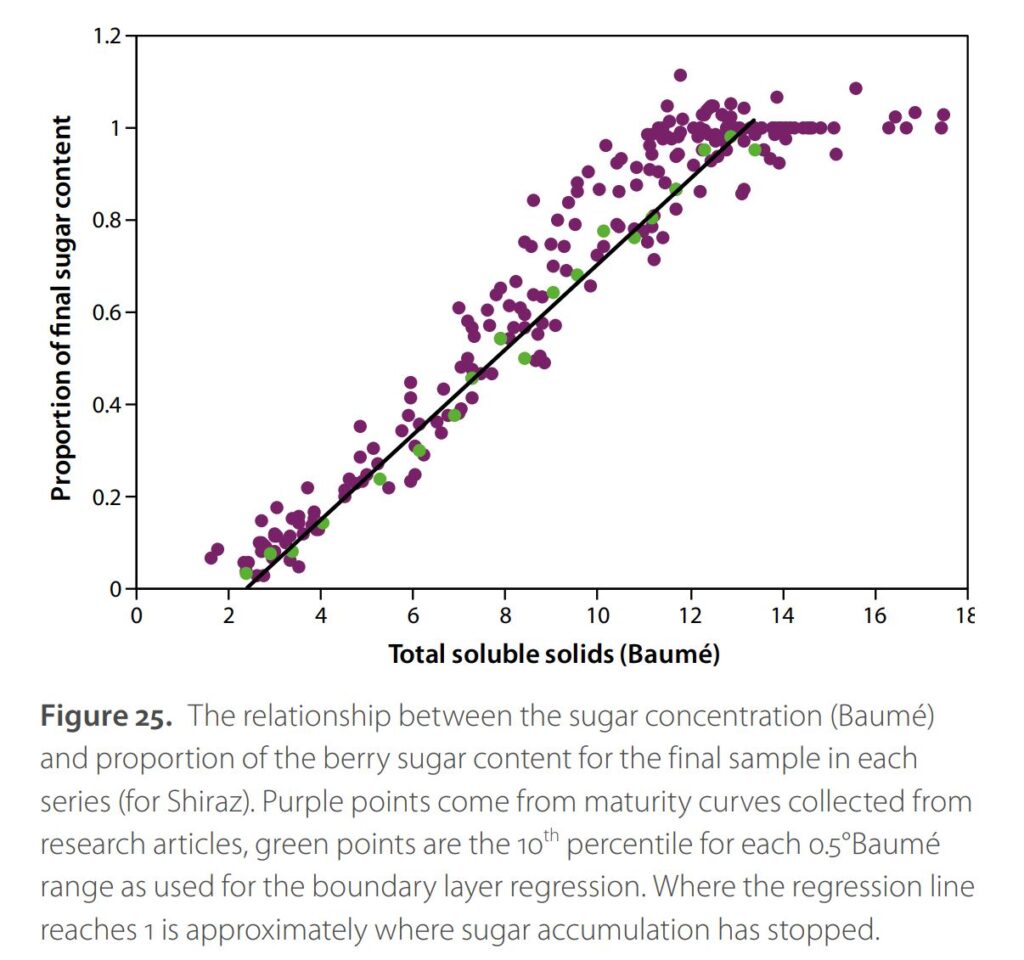Managing the impact of vintage advancement and compression
Project summary
Vintage compression places significant stress on harvest and processing logistics and capacity. However, the contribution to this phenomenon of management practices (e.g. improved irrigation or pruning), has not been separated from the effect of higher temperatures. In addition, trends in fruit maturity parameters other than sugar accumulation need to be investigated, as does the balance between titratable acidity (TA) and pH with sugar concentration. A better understanding of these trends will corroborate their likely relevance in future vintages, and inform both winery and vineyard management decisions.
Another important symptom of vintage compression, is delays in harvesting fruit and resulting high sugar/alcohol concentrations. Increases in grape sugar concentrations can be driven by the import of sugar from the vine, or by berry dehydration. Dehydration also results in a loss in yield, with a significant impact on vineyard profitability. A better understanding of the dynamics of sugar accumulation and aroma-relevant grape compositional changes, may aid harvest decisions and inform appropriate compensation for delays in picking fruit.
Another option to manage vintage compression is to increase the speed at which fruit can be processed. For red wines the major processing bottleneck is red fermenter capacity. Faster extraction techniques (including thermovinification and flash détente) can reduce the time that red ferments need to be in contact with skins. Unfortunately, these techniques can produce undesirable or non-traditional flavour profiles, which may make their adoption less attractive to industry. A range of extraction processing options will be investigated for red grapes on a commercial scale, to target more desirable and familiar colour, texture, and flavour outcomes.
The research plan includes:
- an extension of the analysis of the maturity dataset from Treasury Wine Estates for TA and pH, in order to track changes in these parameters (and their balance with sugar) from the late 1990s
- an evaluation of models for assessing the likely impact of climate change on TA and pH (and their balance with sugar)
- data analysis across a range of research data sets (already collected) of sugar accumulation and berry weight, to separate the impact of sugar importation vs berry dehydration
- characterisation of the impact of the amount, timing and methods of water addition on wine composition and style.
Additional chemistry and sensory support will be provided from Projects 3.1.1 (volatile aroma compounds) and 3.1.4 (managing wine extraction).
Latest information
Understanding sugar accumulation by berries
Vintage compression can lead to a delay in harvest and fruit being picked with higher than ideal sugar concentrations and less desirable flavour characteristics. To help avoid fermentation problems with high-sugar grapes, FSANZ regulations now allow the pre-fermentation dilution of must to 13.5°Baumé. By establishing a lower limit for sugar concentration, this has shifted the focus towards the mass of sugar produced, in addition to the mass of grapes harvested. Under the revised regulations, knowing the point when sugar movement into the fruit ceases becomes an extra parameter to consider when optimising harvest decision-making, along with fruit maturity and flavour profile. While other key quality parameters such as acids, anthocyanins and phenolics may change as ‘hang time’ is extended, potentially improving the quality of the final wine, it is important to recognise that the further increase in sugar concentration in the fruit is due to dehydration of the berries. However, as grapegrowers are paid based on the yield of grapes, conflict may occur between growers and wineries when high sugar concentrations occur due to fruit dehydration as opposed to the importation of sugar into the grapes.

The goals of this work were to conduct a meta-analysis of studies on grape ripening across Australian growing regions for Shiraz and Cabernet Sauvignon, to determine the range of sugar concentrations (and specifically the maximum) at which sugar accumulation ceases. Boundary layer regression was used to determine the maximum sugar concentration where the sugar content per berry stopped increasing. For Shiraz this was 13°Baumé and for Cabernet Sauvignon it was closer to 14.5°Baumé. The information will serve as guide to producers of these varieties to predict when fruit dehydration is likely to occur and to help optimise the decision on when to harvest grapes.
Can dilution of grape must address the effects of vintage compression without a loss of wine quality?
The revised FSANZ regulations allow must to be diluted with water to a minimum of 13.5°Baumé. The rationale behind this change was to reduce the chances of problems arising during fermentation; however, an additional benefit may be to help industry manage the logistical problems caused by compressed vintage periods. To help understand the effects of dilution on wine composition and quality, a study was conducted using Chardonnay grapes sourced from the moderate to warm region Currency Creek in SA. Chardonnay was harvested at 14.5 and 15.5°Baumé and diluted to 13.5°Baumé using direct addition of rainwater to the must. An earlier harvest at 13.5°Baumé was included for comparison. Sensory assessment showed that differences between the wines were small, with the main attribute affected by dilution being hotness. Hotness was similar between the 13.5 and 14.5°Baumé control wines, and the diluted 14.5°Baumé treatment. Not surprisingly, the 15.5°Baumé wine was rated highest for hotness. However, it was interesting to note that the diluted 15.5°Baumé treatment had the lowest perceived hotness, despite having a similar alcohol concentration to the reference treatments. Various sensory attributes were assessed for the wines such as ‘confection’ aroma, ‘stone fruit’ flavour and ‘citrus’ flavour, but these were not significantly different among the wines. Only yellow colour was found to increase significantly with ripening, and was highest in both the diluted and control 15.5°Baumé wines. These preliminary results show that water addition may be used for Chardonnay, in accordance with the FSANZ regulations, without significant negative impacts.
Project Contact
Keren Bindon

